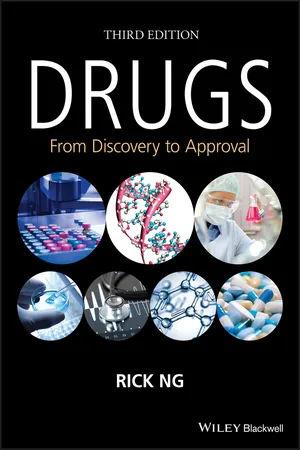
- English
- ePUB (mobile friendly)
- Available on iOS & Android
About this book
The third edition of this best-selling book continues to offer a user-friendly, step-by-step introduction to all the key processes involved in bringing a drug to the market, including the performance of pre-clinical studies, the conduct of human clinical trials, regulatory controls, and even the manufacturing processes for pharmaceutical products.
Concise and easy to read, Drugs: From Discovery to Approval, Third Edition quickly introduces basic concepts, then moves on to discuss target selection and the drug discovery process for both small and large molecular drugs. The third edition incorporates the latest developments and updates in the pharmaceutical community, provides more comprehensive coverage of topics, and includes more materials and case studies suited to college and university use. Biotechnology is a dynamic field with changes across R&D, clinical trials, manufacturing and regulatory processes, and the third edition of the text provides timely updates for those in this rapidly growing field.
Frequently asked questions
- Essential is ideal for learners and professionals who enjoy exploring a wide range of subjects. Access the Essential Library with 800,000+ trusted titles and best-sellers across business, personal growth, and the humanities. Includes unlimited reading time and Standard Read Aloud voice.
- Complete: Perfect for advanced learners and researchers needing full, unrestricted access. Unlock 1.4M+ books across hundreds of subjects, including academic and specialized titles. The Complete Plan also includes advanced features like Premium Read Aloud and Research Assistant.
Please note we cannot support devices running on iOS 13 and Android 7 or earlier. Learn more about using the app.
Information
CHAPTER 1
INTRODUCTION
1.1 AIM OF THIS BOOK
Exhibit 1.1 FDA Definition of a Drug
- A substance recognized by an official pharmacopeia or formulary.
- A substance intended for use in the diagnosis, cure, mitigation, treatment, or prevention of disease.
- A substance (other than food) intended to affect the structure or any function of the body.
- A substance intended for use as a component of a medicine but not a device or a component, part or accessory of a device.
- Biological products are included within this definition and are generally covered by the same laws and regulations, but differences exist regarding their manufacturing processes (chemical process vs biological process).
1.2 AN OVERVIEW OF THE DRUG DISCOVERY TO APPROVAL PROCESS
Table of contents
- COVER
- TITLE PAGE
- TABLE OF CONTENTS
- PREFACE
- CHAPTER 1: INTRODUCTION
- CHAPTER 2: DRUG DISCOVERY: TARGETS AND RECEPTORS
- CHAPTER 3: DRUG DISCOVERY: SMALL MOLECULE DRUGS
- CHAPTER 4: DRUG DISCOVERY: LARGE MOLECULE DRUGS
- CHAPTER 5: DRUG DEVELOPMENT AND PRECLINICAL STUDIES
- CHAPTER 6: CLINICAL TRIALS
- CHAPTER 7: REGULATORY AUTHORITIES
- CHAPTER 8: REGULATORY APPLICATIONS
- CHAPTER 9: GOOD MANUFACTURING PRACTICE: REGULATORY REQUIREMENTS
- CHAPTER 10: GOOD MANUFACTURING PRACTICE: DRUG MANUFACTURING
- CHAPTER 11: FUTURE PERSPECTIVES
- APPENDIX 1: HISTORY OF DRUG DISCOVERY AND DEVELOPMENT
- APPENDIX 2: CELLS, NUCLEIC ACIDS, GENES, AND PROTEINS
- APPENDIX 3: SELECTED DRUGS AND THEIR MECHANISMS OF ACTION
- APPENDIX 4: A DHFR PLASMID VECTOR
- APPENDIX 5: VACCINE PRODUCTION METHODS
- APPENDIX 6: VACCINES APPROVED BY FDA
- APPENDIX 7: PHARMACOLOGY/TOXICOLOGY REVIEW FORMAT
- APPENDIX 8: EXAMPLES OF GENERAL BIOMARKERS
- APPENDIX 9: TOXICITY GRADING
- APPENDIX 10: HEALTH SYSTEMS IN SELECTED COUNTRIES
- ACRONYMS
- GLOSSARY
- INDEX
- END USER LICENSE AGREEMENT